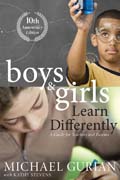
Boys and girls learn differently! a guide for teachers and parents: revised 10th anniversary edition
Gurian, Michael
Stevens, Kathy
This is a thoroughly revised edition of the classic resource for understanding gender differences in the classroom. In this profoundly significant book, author Michael Gurian has revised and updated his groundbreaking book that clearly demonstrated how the distinction in hard-wiring and socialized gender differences affects how boys and girls learn. Gurian presents a proven method to educate our children based on brain science, neurological development, and chemical and hormonal disparities. The innovations presented in this book were applied in the classroom and proven successful, with dramatic improvements in testscores, during a two-year study that Gurian and his colleagues conducted in six Missouri school districts. This title explores the inherent differences between the developmental neuroscience of boys and girls. It reveals how the brain learns. It explains when same sex classrooms are appropriate, and when they're not. This edition includes new information on a wealth of topics including how to design the ultimate classroom for kids in elementary, secondary, middle, and high school. INDICE: Acknowledgments. Introduction. Who We Are and What We Do. How to Use This New Edition. Success Stories Since the Missouri Pilot. Innovating WithSingle-Sex Options. Moving Forward at the Nexus of Science and Practice. PartOne How Boys and Girls Learn Differently. 1 How the Brain Learns: Inherent Differences Between Boys and Girls. The Wide Spectrum of Gender in the Brain. How the Brain Works. How Boys' and Girls' Minds Are Different. Developmental andStructural Differences. Chemical Differences. Hormonal Differences. Functional Differences. Differences in Processing Emotion. Why the Brains Are Different. A Brief History of Brain Difference. The Role of Hormones in the Womb and atPuberty. 2 How Brain-Based Differences Affect Boys and Girls. Areas of Learning-Style Difference. Deductive and Inductive Reasoning. Abstract and Concrete Reasoning. Use of Language. Logic and Evidence. The Likelihood of Boredom. Movement. Sensitivity and Group Dynamics. Use of Symbolism. Use of Learning Teams. Learning Differences and the Intelligences. Time and Sequence. Space and Place. Applying the Intelligences to Brain-Based Gender Difference. The State of Boys and Girls in Our Schools. Advantages for Boys, Challenges for Girls. Advantages for Girls, Challenges for Boys. Applying Brain-Based Research to GenderAdvantage. Studies Based on Political Assumptions. The Political Search for Workplace Privation. Creating the Ultimate Classroom. Part Two Creating the Ultimate Classroom for Both Boys and Girls. Authors' Note. 3 The Ultimate Preschool and Kindergarten Classroom. The Foundation of Early Learning: Bonding and Attachment. Handling Children's Emotional Stress. Bonding and Attachment Solutions. Day Care, Preschool, and Kindergarten Community Building. The Case for Preschool. Parents as Teachers. The Parent Education Coordinator. Nutrition and Learning. Carbohydrates, Proteins, and the School Day. Fatty Acids. Dealing with Aggressive Behavior. Aggression Nurturance. Increasing Empathy Nurturance and Verbalization. Discipline Techniques. The Outdoor Classroom. Directing Boysand Girls to Academic Excellence. Teaching Math and Spatials. Language Development Special Education. Creating a Tribe: Bonding and School-Home Alliances. Use of Psychotropic Medications. The Ultimate Preschool and Kindergarten Classroom for Both Boys and Girls. For the Boys. For the Girls. Tips for Parents. 4The Ultimate Elementary School Classroom. Structural Innovations. Use of School Time. Class Size, Number of Teachers, and Teacher-to-Student Ratio. Using Group Dynamics and Group Work as a Basis of Pedagogy. Use of Computers and Other Media in Elementary School. The Outdoor Classroom. Bonding and Attachment inElementary Learning. Handling Students' Emotional Stress. The Role of the Mentor. Community Collaboration: Mentors from Outside the School. How to Provide Discipline in the Elementary Classroom. Learning from Past Mistakes. Discipline Techniques After an Offending Act. Discipline Techniques to Prevent Undisciplined Behavior. Motivation Techniques. Character Education. CHARACTERplus. Integrating Character Education into the Whole School. Dealing with Cruelty, Hazing, and Violence. Definition of Terms. Zero-Tolerance Policies. Innovations for Academic Excellence. Innovations for Teaching Language Arts, Especially Reading and Writing. Innovations for Teaching Math and Science. Standardized Testing. Special Education, Learning Disabilities, and Behavioral. Disabilities. Class Within a Class. Fast ForWord. Other Spatial Stimulants and Use of Movement. The Multisensory Approach to Reading Problems. Cooperative and Competitive Learning. Sports and Athletics. The Ultimate Elementary Classroom for Both Boysand Girls. For the Boys. For the Girls. Tips for Parents. 5 The Ultimate Middle SchoolClassroom. Structural Innovations. Single-Sex Education. Rites of Passage. Use of Uniforms. Classroom Size and Other Innovations. Bonding and Attachment. The Early Adolescent's Drop in Self-Esteem. Handling Students' Emotional Stresses. Community Collaboration. How to Provide Discipline in the Middle School Classroom. Strategies for Providing Discipline. Mandatory Sports. Character Education. Innovations for Teaching Language Arts and Math and Science. Innovations for Teaching Language Arts. Innovations for Teaching Math and Science. Girls and Computer Science. Special Education. Rethinking Special EducationThrough the Lens of Gender and the Brain. Innovations for Dealing with Behavioral Elements of Special Ed. The Underachiever as a Special Ed Category. Mr. Daba: The Power of Bonding. The Ultimate Middle School Classroom for Both Boys and Girls. For the Boys. For the Girls. Tips for Parents. 6 The Ultimate High School Classroom. Bonding and Attachment. Communication and Conflict Resolution. The Art of Mentoring. Peer Leadership, Not Peer Pressure. Discipline Systems. Character Education and Service Projects. Structural Innovations. Class andSchool Size. Uniforms. Time and Time-of-Day Innovations. The Innovations Students Are Asking For. Counterinnovations. Rites of Passage. Full Psychosocial Education, Not Just Sex Education. Improving Sex Education. Gender Education. Innovations to Improve Academic Learning. Teaching Mathematics, Science, and Technology. Technology and Gender. Teaching Reading and Literacy. Standardized Testing. Special Education. The Ultimate High School Classroom for Both Boys and Girls. For the Boys. For the Girls. Tips for Parents. What High School Students Are Saying: Their Fears. Epilogue. Notes. Parents' Book Study for Boys andGirls Learn Differently! Teachers' Book Study for Boys and Girls Learn Differently! The Gurian Institute. The Authors. Index.
- ISBN: 978-0-470-60825-8
- Editorial: John Wiley & Sons
- Encuadernacion: Rústica
- Páginas: 400
- Fecha Publicación: 27/10/2010
- Nº Volúmenes: 1
- Idioma: Inglés
